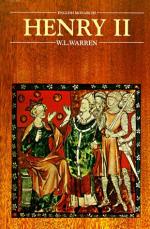saw the magnificent troop of Raymond’s cousins
and nephews, who had thrown aside all armour save
shields, and, mounted on splendid horses, dashed across
the plain to display their feats of agility and horsemanship,
he muttered to his followers, “This pride I
will shortly abate, and these shields I will scatter.”
He was true to his word. The fortunes of the
knights of both parties indeed rapidly declined; “those
who had been first had to learn to be last;”
their lands were taken from them on every excuse,
and they were followed by the enmity and persecution
of the king. For the next ten years the history
of the English in Ireland is a miserable record of
ineffective and separate wars undertaken by leaders
each acting on his own account, and of watchful jealousy
on the part of Henry. A new governor was sent
in 1177 to replace Fitz-Aldhelm. Hugh de Lacy
was no Norman. His black hair, his deep-set black
eyes, his snub nose, the scar across his face, his
thin ill-shapen figure, marked him out from the big
fair Fitz-Geralds, as much as did his “Gallican
sobriety” and his training in affairs, for in
war he had no great renown. Perhaps it was some
quick French quality in him that won the love of the
Irish. But Henry was suspicious and uneasy.
He was recalled in 1181 on the news that without the
king’s leave he had married the daughter of
the King of Connaught, and rumour added that he had
even made ready a diadem for himself. But his
services were so valuable that that same winter he
was sent back, only to be again recalled in 1184 and
again sent back. At last in 1186, “as though
fortune had been zealous for the king of England,”
he was treacherously slain by an Irishman, to Henry’s
“exceeding joy.”
Meanwhile the king had in 1185 made a further attempt
at a permanent settlement of the distracted island.
John was formally appointed king over Ireland, and
accompanied by Glanville, landed in Waterford on the
25th of April. His coming with a new batch of
Norman followers completed the misfortunes of the
first settlers. The Norman-Welsh knights of the
border had by painful experience learned among their
native woods and mountains how to wage such war as
was needed in Ireland-a kind of war where armour was
worse than useless, where strength was of less account
than agility, where days and nights of cold and starvation
were followed by impetuous assaults of an enemy who
never stood long enough for a decisive battle, a war
where no mercy was given and no captives taken.
On the other hand, their half Celtic blood had made
it easy for them to mingle with the Irish population,
to marry and settle down among them. But the
followers of John were Norman and French knights,
accustomed to fight in full armour upon the plains
of France; and to add to a rich pay the richer profits
of plunder and of ransom. The seaport towns and
the castles fell into the hands of new masters, untrained
to the work required of them. “Wordy chatterers,
swearers of enormous oaths, despisers of others,”




